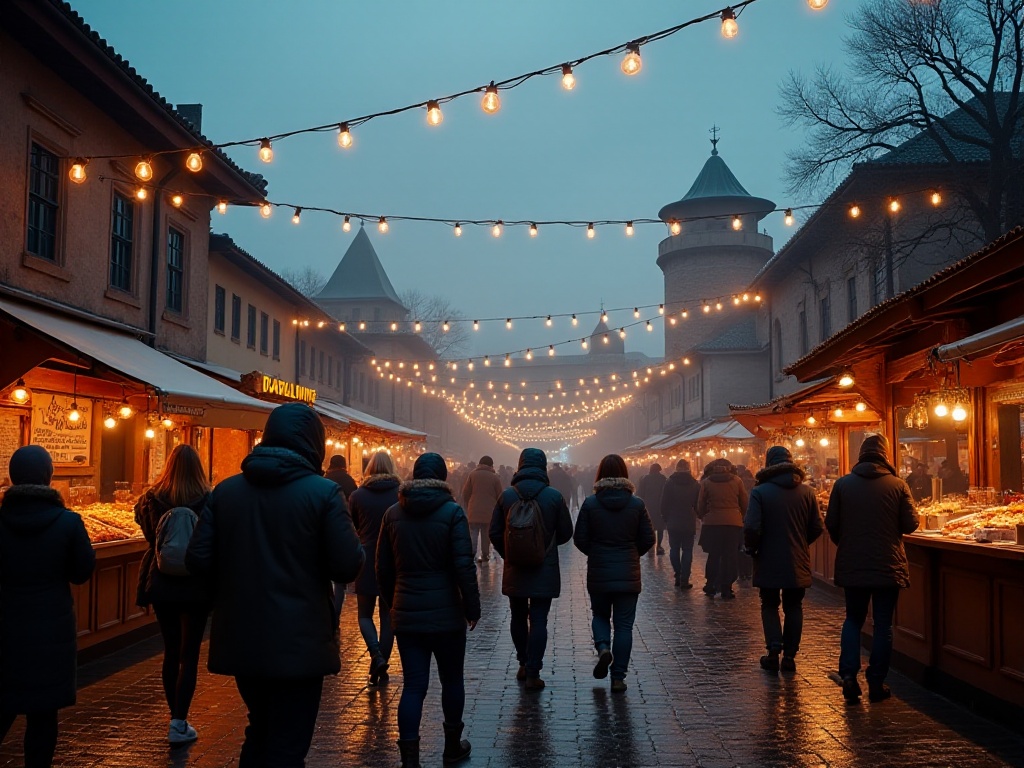As someone who has lived in Guangzhou for over a decade and considers themselves "half Guangzhounese," I've fallen deeply in love with every aspect of this city. Whenever foreign friends visit, I carefully design a route that allows them to experience the essence of this city in just 24 hours. Today, let me take you on this unique Guangzhou journey with my British friend Tom.
At 6 AM, while Guangzhou's sky still held traces of darkness, the city was already awakening. Tom and I entered a century-old tea house in the Liwan District. Pushing open the heavy wooden door, we were greeted by the rich aroma of tea. Old-style ceiling fans turned slowly, and black and white photographs on the walls told stories of the city's past.
The tea house was already filled with diners, mostly elderly Guangzhou residents leisurely reading newspapers and occasionally chatting with their neighbors. Tom found this atmosphere fascinating, saying that in Britain, breakfast is usually a casual affair at home, and people rarely go out specifically for breakfast.
"Ding-ling, ding-ling," the dim sum cart lady passed by our table. Tom's eyes widened like a curious child, looking around. I introduced him to these exquisite Cantonese dim sum: crystal shrimp dumplings, honey barbecue pork buns, silky rice noodle rolls, egg tarts, lotus paste buns, ham sui gok... each one a proud symbol of Guangzhou's morning tea culture.
We ordered a basket of shrimp dumplings. Tom carefully picked one up with his chopsticks, seeing the pink shrimp through the transparent wrapper. "This is so delicate!" he exclaimed. I told him that a perfect shrimp dumpling requires a thin, translucent skin with even pleats and fresh, springy shrimp – a true test of a dim sum chef's skill.
The sweet aroma of the char siu bao earned endless praise from Tom. He said you could get char siu bao in London's Chinese restaurants, but they taste completely different. I explained that the essence of Cantonese char siu lies in the perfect balance of lean and fat meat, neither too greasy nor too sweet.
What delighted Tom most was the cheung fun. When the server poured soy sauce over the translucent rice noodle rolls, releasing their fragrance, he couldn't wait to take a bite. "The texture is amazing," he said, "smooth yet chewy, and perfectly matched with the sweet and savory sauce!"
We also ordered a pot of pu'er tea. Tea connoisseurs say you must pair morning tea with pu'er because it helps cut through the richness. I couldn't help but smile watching Tom learning to brew tea with a gaiwan. He said this tea ceremony was more sophisticated than British afternoon tea.

After morning tea, we walked to Chen Clan Ancestral Hall. In the early morning streets of old Liwan District, shops were gradually opening, and old neighbors greeted each other. Tom said it reminded him of London's old quarter, but Guangzhou's daily life atmosphere was more vibrant.
Upon entering Chen Clan Ancestral Hall, Tom was immediately drawn to the stone lions at the entrance. I told him that this was built with funds from overseas Chinese from 72 counties in Guangdong during the Qing Dynasty, providing a place for sojourners to worship their ancestors. The entire complex covers over 13,000 square meters and represents the finest of Lingnan architectural art.
Stepping inside, Tom was amazed by the carved artworks. The ridge decorations on the roof, brick carvings on the walls, and wooden carvings on doors and windows were all intricately crafted. I specifically showed him the famous "Large Wood Carving 'Hundred Birds Paying Homage to the Phoenix'," which took three years to complete and features various birds and beasts carved in lifelike detail.
"The most amazing thing," I told Tom, "is that the entire building was constructed without a single nail, using only mortise and tenon joints." He shook his head in disbelief after hearing this. We strolled slowly through the ancestral hall, admiring every detail. Sunlight filtered through the carved window lattices, creating dappled shadows on the ground, as if time had returned to a century ago.
In the exhibition hall of Chen Clan Academy, we saw many historical materials about Guangdong's overseas Chinese. Tom was very interested in this history, saying he hadn't realized Guangdong people had gone global so early. I told him it was these well-traveled Cantonese who brought an open and inclusive character to Guangzhou.

After visiting Chen Clan Academy, we walked to Shangxiajiu Pedestrian Street. This century-old commercial street has witnessed Guangzhou's commercial development history and remains bustling today. The arcade buildings along both sides of the street retain their early 20th-century appearance, with various shops on the ground floor.
I took Tom to a wonton noodle shop that has been operating for over sixty years. Though small, it's always packed. Yellowed old photos and celebrity autographs hang on the walls. The owner, a third-generation proprietor, gets up at 4 AM every day to prepare the soup base.
Tom looked bewildered at the menu, so I ordered the signature wonton noodles for him. Soon, a steaming bowl of noodles arrived. The broth was clear, revealing golden noodles and translucent wontons beneath. I taught him to taste the soup first, then eat the wontons and noodles together.
"This soup is incredible!" Tom exclaimed. I explained that it's superior stock made by simmering dried shrimp, pork bones, and wonton wrapper trimmings for several hours, available in limited quantities daily. The wonton filling is also particular, using fresh shrimp and pork mince seasoned with scallions and ginger, wrapped thinly yet securely.
Tom said this completely changed his impression of Chinese noodles. In his mind, Chinese noodles were just instant noodles. I laughed and told him that Guangzhou people have high standards for food - even a simple bowl of noodles requires precise timing and skill.

In the afternoon, we took the metro to Zhujiang New Town. Moving from the old town to the modern business district felt like traveling through time. Towering office buildings and wide, clean streets everywhere showcase the atmosphere of a modern metropolis.
Tom found this strong contrast fascinating. He said in London, modern and historical buildings transition gradually, but in Guangzhou, you seem to cross a century in one step. I told him this is Guangzhou's character - maintaining its thousand-year heritage as a commercial capital while embracing modernization.
We arrived at the base of Canton Tower. This modern building, nicknamed the "Slim Waist," is Guangzhou's new landmark. Tom said it reminded him of London's Shard, but Canton Tower's design was more elegant. We went up to the observation deck to overlook the entire city. The Pearl River winds through the city center like a jade belt, with buildings on both banks gleaming in the sunlight.
In Zhujiang New Town, we visited the Guangdong Museum. This modern building houses a large collection of Lingnan artifacts, showing Guangdong's historical evolution from the Neolithic Age to modern times. Tom was particularly interested in the Cantonese Opera section, saying the beautiful costumes and props reminded him of the Shakespeare's Globe Theatre exhibition.

At dusk, we arrived at Shamian Island. The European-style buildings looked particularly romantic in the sunset. The former British and French concession from a century ago has become a popular leisure spot for citizens. We strolled along the tree-lined paths, watching young people taking photos in front of the historic buildings.
Tom said these buildings reminded him of Victorian London, but with unique Lingnan characteristics. We sat down at a café and ordered coffee. Through the window, we could see the Pearl River view and the modern building complex across the river. This blend of old and new is precisely Guangzhou's charm.
After nightfall, we moved to Beijing Road Pedestrian Street. This is one of Guangzhou's busiest commercial streets, with various food stalls, street performers, and specialty shops creating a lively urban night scene. We tasted Guangzhou specialties like double-skin milk pudding, claypot rice, and boat congee. Tom said these street foods were more interesting than Michelin-starred restaurants.
On Beijing Road, we also saw the remains of Tang Dynasty city walls. Under transparent glass displays, the thousand-year-old walls silently tell the city's history. Tom said it reminded him of London's city walls, both witnesses to ancient civilization in modern cities.

In the taxi back, Tom was full of emotion. He said that in this one day, he not only saw a modern metropolis but felt a continuously living cultural heritage. From morning tea to night markets, from historic sites to new districts, Guangzhou interprets China's urban development path in its unique way.
This reminded me of an old saying: Guangzhou is a city you never want to leave once you arrive. It's inclusive, open, and full of vitality, preserving traditional essence while constantly embracing new possibilities. Everyone can find their own warmth and surprises here.
Tom said he would definitely return because one day isn't enough to know this city. Indeed, like tasting tea, Guangzhou's flavor needs to be savored slowly. Each revisit brings new surprises and different experiences.
This is the Guangzhou I know - a city that stays forever young yet grows more profound with age. It's like a book that can never be finished, each page filled with fascinating stories. And we are the witnesses and messengers of these stories.
 Previous
Previous
